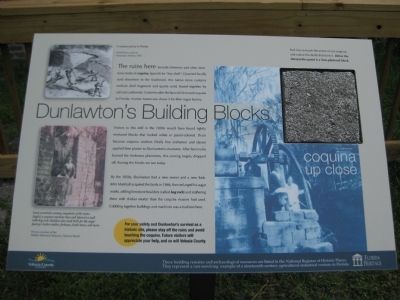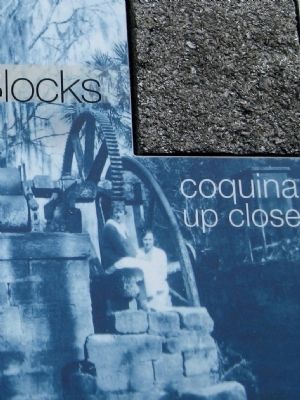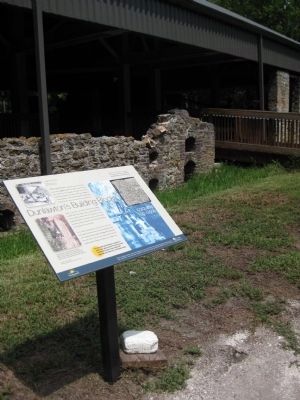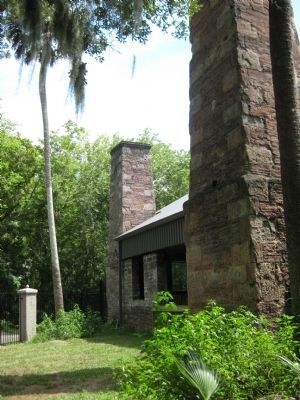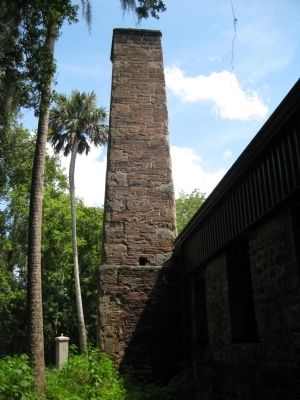Port Orange in Volusia County, Florida — The American South (South Atlantic)
Dunlawton's Building Blocks
coquina up close
Visitors to this mill in the 1830s would have found tightly mortared blocks that looked white or pastel-colored. That's because coquina workers (likely free craftsmen and slaves) applied lime plaster to Dunlawton's structures. After Seminoles burned the Anderson plantation, this coating largely dropped off, leaving the blocks we see today.
By the 1850's, Dunlawton had a new owner and a new look. John Marshall acquired the lands in 1846, then enlarged his sugar works, adding limestone boulders (called bog rock) and slathering them with thicker mortar than the coquina masons had used. Cobbling together buildings and machines was a tradition here.
For your safety and Dunlawton's survival as a historic site, please stay off the ruins and avoid touching the coquina. Future visitors will appreciate your help, and so will Volusia County.
[ Illustration ]
A coquina quarry in Florida.
Detail from a print in Picturesque America, 1872.
[ Photos ]
Early twentieth-century snapshots of the ruins: a coquina machine base and a wall with bog rock. Builders also used brick for the sugar factory's boiler cradles, fireboxes, kettle bases, and more.
Photos courtesy of the Halifax Historical Museum, Daytona Beach
Feel free to touch this piece of cut coquina, and notice the shells that form it. Below the interpretive panel is a lime-plastered block.
These building remains and archaeological resources are listed in the National Register of Historic Places. They represent a rare surviving example of a nineteenth-century agricultural-industrial venture in Florida.
Erected by Volusia County and the State of Florida, Department of State, Division of Historical Resources, assisted by the Florida Historical Commission.
Topics. This historical marker is listed in these topic lists: Industry & Commerce • Wars, US Indian. A significant historical year for this entry is 1846.
Location. 29° 8.476′ N, 81° 0.352′ W. Marker is in Port Orange, Florida, in Volusia County. Marker is on Old Sugar Mill Road east of Herbert Street, on the left when traveling east. The marker is on the grounds of the Dunlawton Sugar Mill Botanical Gardens. Touch for map
. Marker is at or near this postal address: 950 Old Sugar Mill Road, Port Orange FL 32129, United States of America. Touch for directions.
Other nearby markers. At least 8 other markers are within walking distance of this marker. Sugar Making (here, next to this marker); Spanish Mills and Bongoland (here, next to this marker); The Dunlawton Sugar Factory (a few steps from this marker); Living on the Edge (a few steps from this marker); The Most Dangerous Chieftain (a few steps from this marker); Telling Dunlawton's Stories (a few steps from this marker); From the Boardwalk (a few steps from this marker); Emathla (King Philip) (a few steps from this marker). Touch for a list and map of all markers in Port Orange.
More about this marker. The marker's upper-left section includes a block of coquina. The marker features the logos of Volusia County and the Florida Heritage program.
Regarding Dunlawton's Building Blocks. Coquina is a sedimentary rock and type of limestone which is found along North Atlantic coastal regions between North Carolina and Florida, as well as Western Australia and New Zealand.
Instances of its use during the Spanish colonial period can be seen to the north in St. Augustine, at the Castillo de San Marcos National Monument.
Coquina is named for the mollusk of the same name,
which has the scientific designation Donax variabilis. The rock is largely composed of their tiny shells, typically 15 - 25 mm in length. The small saltwater clams are found in abundance along nearby ocean shores. The coquina clam is edible and was consumed by native Americans, but is rarely eaten today.
The Dunlawton site was listed with the National Register of Historic Places in 1973 under the name Dunlawton Plantation--Sugar Mill Ruins (# 73000606).
Related markers. Click here for a list of markers that are related to this marker. To better understand the story of the Dunlawton Plantation and Sugar Mill Ruins, study each marker in the order shown.
Also see . . . Coquina. Wikipedia entry on coquina rock (Submitted on August 27, 2011, by Glenn Sheffield of Tampa, Florida.)
Credits. This page was last revised on June 16, 2016. It was originally submitted on August 26, 2011, by Glenn Sheffield of Tampa, Florida. This page has been viewed 886 times since then and 25 times this year. Photos: 1. submitted on August 26, 2011, by Glenn Sheffield of Tampa, Florida. 2, 3, 4, 5. submitted on August 27, 2011, by Glenn Sheffield of Tampa, Florida. • Bill Pfingsten was the editor who published this page.
